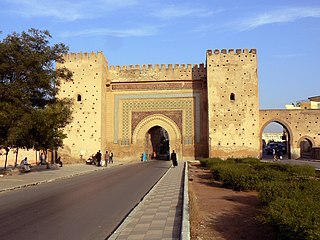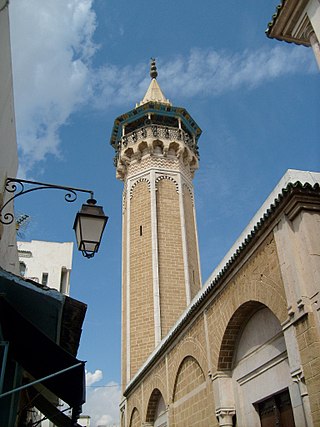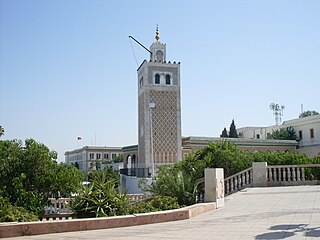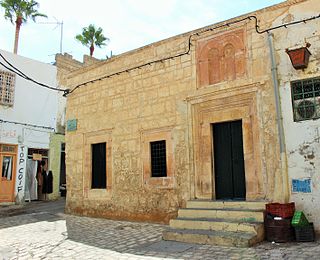
Tunis is the capital and largest city of Tunisia. The greater metropolitan area of Tunis, often referred to as "Grand Tunis", has about 2,700,000 inhabitants. As of 2020, it is the third-largest city in the Maghreb region and the eleventh-largest in the Arab world.

Meknes is one of the four Imperial cities of Morocco, located in northern central Morocco and the sixth largest city by population in the kingdom. Founded in the 11th century by the Almoravids as a military settlement, Meknes became the capital of Morocco during the reign of Sultan Moulay Ismaïl (1672–1727), son of the founder of the Alaouite dynasty. Moulay Ismaïl created a massive imperial palace complex and endowed the city with extensive fortifications and monumental gates. The city recorded a population of 632,079 in the 2014 Moroccan census. It is the seat of Meknès Prefecture and an important economic hub in the region of Fès-Meknès.

Sfax is a city in Tunisia, located 270 km (170 mi) southeast of Tunis. The city, founded in AD 849 on the ruins of Berber Taparura, is the capital of the Sfax Governorate, and a Mediterranean port. Sfax has a population of 330,440. Its main industries include phosphate, olive and nut processing, fishing and international trade. The city is the second-most populous in the country after the capital, Tunis.

Fes el Bali is the oldest walled part of Fez, the second largest city of Morocco. Fes el Bali was founded as the capital of the Idrisid dynasty between 789 and 808 AD. UNESCO listed Fes el Bali, along with Fes Jdid, as a World Heritage Site in 1981 under the name Medina of Fez. The World Heritage Site includes Fes el Bali's urban fabric and walls as well as a buffer zone outside of the walls that is intended to preserve the visual integrity of the location. Fes el Bali is, along with Fes Jdid and the French-created Ville Nouvelle or “New Town”, one of the three main districts in Fez.

Moorish architecture is a style within Islamic architecture which developed in the western Islamic world, including al-Andalus and what is now Morocco, Algeria, and Tunisia. Scholarly references on Islamic architecture often refer to this architectural tradition in terms such as architecture of the Islamic West or architecture of the Western Islamic lands. The use of the term "Moorish" comes from the historical Western European designation of the Muslim inhabitants of these regions as "Moors". Some references on Islamic art and architecture consider this term to be outdated or contested.

Al-Zaytuna Mosque, also known as Ez-Zitouna Mosque, and El-Zituna Mosque, is a major mosque at the center of the Medina of Tunis in Tunis, Tunisia. The mosque is the oldest in the city and covers an area of 5,000 square metres with nine entrances. It was founded at the end of the 7th century or in the early 8th century, but its current architectural form dates from a reconstruction in the 9th century, including many antique columns reused from Carthage, and from later additions and restorations over the centuries. The mosque hosted one of the first and greatest universities in the history of Islam. Many Muslim scholars graduated from al-Zaytuna for over a thousand years. Ibn 'Arafa, a major Maliki scholar, al-Maziri, the great traditionalist and jurist, and Aboul-Qacem Echebbi, a famous Tunisian poet, all taught there, among others.

Youssef Dey Mosque, also known as Al B'chamqiya, is a 17th-century mosque in Tunis, Tunisia, located in Medina area of the city. The mosque is considered significant as it was the first Ottoman-Turkish mosque to be built in Tunis.

Hammouda Pacha Mosque or Hamouda Pacha al Mouradi is a mosque in Tunis, Tunisia. It is an official historical monument.

Kasbah Mosque is a mosque in Tunis, Tunisia. It is a listed as a Historical Monument.
Hammuda Pasha Bey, died April 13, 1666 was the second Bey of the Tunisian Muradid dynasty. He reigned from 1631 until his death.
The following is a timeline of the history of the city of Tunis, Tunisia.

The Sfax medina is the medina quarter of the Tunisian city of Sfax. It was built by Aghlabid prince Abu Abbass Muhammad between 849 and 851. The medina is home to about 113,000 residents, and is dominated by the Great Mosque of Sfax.

The souks of Tunis are a set of shops and boutiques located in the medina of Tunis, capital of Tunisia. Most of the souks were built under the Hafsid dynasty in the 13th century and near the Al-Zaytuna Mosque.

The Tourbet el Bey is a Tunisian royal mausoleum in the southwest of the medina of Tunis.

El Borj Mosque or Mosque of the tower, also known as Sidi Yahia Mosque is a Tunisian mosque in the northern suburb of the Medina of Tunis.

Sidi El Bahri Mosque, also called masjed Sidi El Bahri, is one of the historical mosques of the medina of Sfax, Tunisia. It is classified as a national monument since 1922.

The architecture of Fez, Morocco, reflects the wider trends of Moroccan architecture dating from the city's foundation in the late 8th century and up to modern times. The old city (medina) of Fes, consisting of Fes el-Bali and Fes el-Jdid, is notable for being an exceptionally well-preserved medieval North African city and is classified as a UNESCO World Heritage Site. A large number of historic monuments from different periods still exist in it today, including mosques, madrasas, synagogues, hammams (bathhouses), souqs (markets), funduqs (caravanserais), defensive walls, city gates, historic houses, and palaces.

The architecture of Tunisia began with the ancient civilizations such as the Carthaginians, Numidians, and Romans. After the 7th century, Islamic architecture developed in the region under a succession of dynasties and empires. In the late 19th century French colonial rule introduced European architecture, and modern architecture became common in the second half of the 20th century. The southern regions of the country are also home to diverse examples of local vernacular architecture used by the Berber (Amazigh) population.

Hafsid architecture developed under the patronage of the Hafsid dynasty in Ifriqiya during the 13th to 16th centuries. Evolving from earlier Almohad and Ifriqiyan traditions, it was later influenced further by Mamluk architecture of Egypt and Syria and it increasingly deviated from the style of Moorish architecture in al-Andalus and the western Maghreb. After Hafsid rule ended, the trends of this architectural style continued to develop and characterize Tunisian architecture during the following Ottoman period.






































